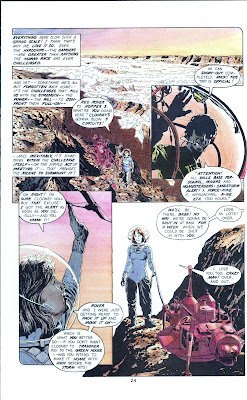Jane Seymour
1974
Sunday, July 15, 2018
Thursday, July 12, 2018
Red Rover, Red Rover by Tim A. Conrad
Red Rover, Red Rover
by Tim A. Conrad
from Thrillogy No. 1, January 1984, Pacific Comics
Another entry from the 'Thrillogy' anthology, featuring work by comics legend Tim A. Conrad.
The color separations and printing technology of the mid-80s can't really do full justice to Conrad's artwork, but still and all it's a nice little sci-fi tale.
by Tim A. Conrad
from Thrillogy No. 1, January 1984, Pacific Comics
Another entry from the 'Thrillogy' anthology, featuring work by comics legend Tim A. Conrad.
The color separations and printing technology of the mid-80s can't really do full justice to Conrad's artwork, but still and all it's a nice little sci-fi tale.
Labels:
Red Rover
Tuesday, July 10, 2018
My Way by Major Harris
Major Harris
'My Way'
Atlantic Records, 1975
In the late Spring and early Summer of 1975, 'Love Won't Let Me Wait' by Major Harris (February 1947 - November 2012) was in heavy rotation on the radio and had reached the top five on both the pop and soul charts.
Although 'Love Won't Let Me Wait' was the standout song from Harris's 1975 album My Way, there were a number of other notable tracks on the album, including what I regard as one of the greatest disco songs ever made: 'Each Morning I Wake Up'.
The 8 minute version of the song is available here.
Harris released a followup album in 1978, How Do You Take Your Love, which unfortunately didn't have the success of My Way. Harris returned to the Delfonics and participated in the group's live shows until his death from heart failure at age 65.
A collection of Harris's songs are available at YouTube and demonstrate his skill as a smooth-groove Soul Man. The spoken intro to 'I Got Over Love' is pure 70s 'soul gold'.
And the album cover art for My Way (which, unfortunately, is uncredited) is outstanding. It's a perfect combination of Art Deco and Superfly-style chic, and something that only the 70s could have spawned.............
'My Way'
Atlantic Records, 1975
In the late Spring and early Summer of 1975, 'Love Won't Let Me Wait' by Major Harris (February 1947 - November 2012) was in heavy rotation on the radio and had reached the top five on both the pop and soul charts.
Although 'Love Won't Let Me Wait' was the standout song from Harris's 1975 album My Way, there were a number of other notable tracks on the album, including what I regard as one of the greatest disco songs ever made: 'Each Morning I Wake Up'.
The 8 minute version of the song is available here.
Harris released a followup album in 1978, How Do You Take Your Love, which unfortunately didn't have the success of My Way. Harris returned to the Delfonics and participated in the group's live shows until his death from heart failure at age 65.
A collection of Harris's songs are available at YouTube and demonstrate his skill as a smooth-groove Soul Man. The spoken intro to 'I Got Over Love' is pure 70s 'soul gold'.
And the album cover art for My Way (which, unfortunately, is uncredited) is outstanding. It's a perfect combination of Art Deco and Superfly-style chic, and something that only the 70s could have spawned.............
Labels:
My Way by Major Harris
Saturday, July 7, 2018
Book Review: In the Flesh
Book Review: 'In the Flesh' by Clive Barker
4 / 5 Stars
The four novellas / short stories that make up 'In the Flesh' first were published in 1986 in the UK as The Books of Blood: Volume 5. This Pocket Books paperback (255 pp) repackaging of these stories for a U.S. readership was published in January, 1988, and features cover art by Jim Warren.
In the title novella, Cleve, an inmate in a British prison, gets a new cellmate: a young man named William 'Billy' Tait. Cleve discovers that Billy Tait has the ability to exit the cell and wander in another dimension during the hours of darkness.
This is the weakest entry in the collection; although the premise is an interesting one, Barker doesn't do much with it other than to paint word pictures of strange, twilight landscapes.
'The Forbidden' is the novelette that formed the basis of the 1992 feature film Candyman. A graduate student named Helen Buchanan, who is writing her thesis on 'Graffitti: The Semiotics of Urban Despair', investigates a notorious murder committed in a public restroom at a decaying Liverpool apartment complex.
This novelette has stood the test of time as a classic 80s horror tale. While Ramsey Campell, another well-known, Liverpool- based horror writer, often used the urban areas of the city as a backdrop for his stories written during the 70s and 80s, Barker is head and shoulders above him with his own skillful use of the setting of a trash-strewn, vandalized housing project as an apt locale for a creepy story.
In 'The Madonna', Jerry Coloqhuon, an aspiring dealmaker, tries to persuade a local mobster named Ezra Garvey to invest in an abandoned swimming pool and bathing complex. But both Coloqhuon and Garvey are astounded to discover that within the dark and humid corridors of the complex lurks a group of nubile young women whose ministrations have a dark purpose.........this is another of the standout entries in 'In the Flesh', with the dilapidated pool complex being a particularly effective setting for a horror tale.
The closing story, 'Babel's Children', takes place in Greece, where a vacationing Vanessa Jape finds herself lost in a remote area well off the beaten path. Seeking directions, Jape stumbles upon what seems to be a convent, only to learn that this seemingly tranquil structure is all that stands between world peace....... and World War Three. 'Babel's Children' is not really a horror story, but more of an entry in the genre of sardonic-humor tale that Roald Dahl was particularly skillful at creating.
The verdict ? More than 30 years after its publication, 'In the Flesh' remains a strong collection of horror stories and a good reminder of Barker's skills as a writer. His fans will of course want to have a copy of either this U.S. paperback, or its UK equivalent.
4 / 5 Stars
The four novellas / short stories that make up 'In the Flesh' first were published in 1986 in the UK as The Books of Blood: Volume 5. This Pocket Books paperback (255 pp) repackaging of these stories for a U.S. readership was published in January, 1988, and features cover art by Jim Warren.
In the title novella, Cleve, an inmate in a British prison, gets a new cellmate: a young man named William 'Billy' Tait. Cleve discovers that Billy Tait has the ability to exit the cell and wander in another dimension during the hours of darkness.
This is the weakest entry in the collection; although the premise is an interesting one, Barker doesn't do much with it other than to paint word pictures of strange, twilight landscapes.
'The Forbidden' is the novelette that formed the basis of the 1992 feature film Candyman. A graduate student named Helen Buchanan, who is writing her thesis on 'Graffitti: The Semiotics of Urban Despair', investigates a notorious murder committed in a public restroom at a decaying Liverpool apartment complex.
This novelette has stood the test of time as a classic 80s horror tale. While Ramsey Campell, another well-known, Liverpool- based horror writer, often used the urban areas of the city as a backdrop for his stories written during the 70s and 80s, Barker is head and shoulders above him with his own skillful use of the setting of a trash-strewn, vandalized housing project as an apt locale for a creepy story.
In 'The Madonna', Jerry Coloqhuon, an aspiring dealmaker, tries to persuade a local mobster named Ezra Garvey to invest in an abandoned swimming pool and bathing complex. But both Coloqhuon and Garvey are astounded to discover that within the dark and humid corridors of the complex lurks a group of nubile young women whose ministrations have a dark purpose.........this is another of the standout entries in 'In the Flesh', with the dilapidated pool complex being a particularly effective setting for a horror tale.
The closing story, 'Babel's Children', takes place in Greece, where a vacationing Vanessa Jape finds herself lost in a remote area well off the beaten path. Seeking directions, Jape stumbles upon what seems to be a convent, only to learn that this seemingly tranquil structure is all that stands between world peace....... and World War Three. 'Babel's Children' is not really a horror story, but more of an entry in the genre of sardonic-humor tale that Roald Dahl was particularly skillful at creating.
The verdict ? More than 30 years after its publication, 'In the Flesh' remains a strong collection of horror stories and a good reminder of Barker's skills as a writer. His fans will of course want to have a copy of either this U.S. paperback, or its UK equivalent.
Labels:
In the Flesh
Friday, July 6, 2018
Subscribe to:
Posts (Atom)

























.jpg)




















